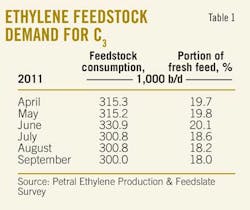US PROPANE — MIDYEAR 2011: US propane trade undergoes historic changes; more likely
Dan Lippe
Petral Worldwide Inc.
Houston
When industry historians review market developments 5 or 10 years from now, they may declare 2009-11 was a major turning point in the history of propane markets in North America. On the other hand, they may conclude this period was an anomaly.
No matter how history decides to judge 2010-11, propane markets experienced developments that promise to have substantial impact on the coming winter heating season. For the immediate future, the shipment of substantial volumes of exports from Houston Ship Channel export terminals was one of the most significant developments during the first three quarters of 2011.
Historically, feedstock demand for propane has been an important and predictable balancing element for the overall propane supply-demand balance in North America. When colder weather pushed sales and consumption in the retail markets steadily higher, ethylene producers in the Gulf Coast generally reduced consumption and effectively offset some or all of the impact of a winter demand. These counterbalancing trends helped keep the overall market in balance. Similarly, feedstock demand generally recovered beginning in March or April as sales and consumption in retail markets fell sharply during March through June. |
Finally, the problem of overstatement of propylene content in refinery propane-propylene production as reported to the US Energy Information Administration plagued propane supply statistics throughout 2010. We concluded this problem worked itself out after January-February 2011 based on detailed analysis of by-product propylene production relative to FCC unit feed rates.
Feedstock demand
Feedstock demand for propane was 320,000 b/d in second-quarter 2011, about 25,000 b/d higher than in first-quarter 2011 and consistent with typical seasonal patterns. Demand in second-quarter 2011 was also 62,000 b/d (24%) higher than demand in second-quarter 2010. Demand averaged about 300,000 b/d in third-quarter 2011, about the same as in 2010.
Propane's share of fresh feed averaged 19.9% during second-quarter 2011 and 18.0% during third-quarter 2011. For third-quarter 2011, feedstock demand was 300,000 b/d and propane's share of fresh feed was 18.0-18.5%. Again, propane's share of fresh feed was below the 2005-07 range of 19.5-22.0%.
Consistent with the ongoing growth in ethane supply and feedstock demand, propane's share of fresh feed during second and third quarters 2011 was less than that for the 2005-07 average of 20.7%—an example of the historic transitions that have been under way since 2009.
Ethylene producers continued to enjoy strong profit margins and total production in second and third quarters 2011 was 2.0% higher than in second and third quarters 2010. Ethylene industry operating rates slipped to 89% in second-quarter 2011, compared with 90% in first-quarter 2011. Operating rates improved to about 91% in third-quarter 2011.
Some indicators, however, point to slower economic growth rates during fourth-quarter 2011 and first-quarter 2012. We forecast ethylene producers will operate at 88-90% of capacity during fourth-quarter 2011 and 86-88% during first-quarter 2012. On this basis, we forecast total demand for fresh feed will average 1.58-1.60 million b/d.
Propane's use as a space-heating fuel in residential-commercial begins to decline sharply from its seasonal peak each year in March. Residential-commercial propane demand began to increase in September-October and will probably reach its peak during December-January. Most likely, demand will be about the same as during winter 2010-11 but there is always the possibility of a colder or warmer winter and higher or lower demand. |
Based on the conclusion that propane availability will be tight at the beginning of winter 2011-12, we forecast feedstock demand for propane will average 220,000-240,000 b/d in fourth-quarter 2011, or 60,000-80,000 b/d lower than in third-quarter 2011 and below fourth-quarter 2010. Our forecasts indicate propane's share of fresh feed will average only 14-15% in fourth-quarter 2011.


